Assessing the Impact of Urbanization and Eco-Environmental Quality on Regional Carbon Storage: A Multiscale Spatio-Temporal Analysis Framework
Abstract
:1. Introduction
2. Material and Methods
2.1. Research Design
- Spatial-temporal change pattern of carbon storage based on the InVEST model;
- Spatial calculation of multidimensional drivers;
- Multiscale-driven assessment of spatial-temporal drivers of carbon storage.
2.2. Study Area
2.3. Data
2.4. Carbon Storage Estimation
2.5. MGWR Model
3. Results
3.1. Patterns of Carbon Storage in Space and Time
3.2. MGWR Results
4. Discussion
4.1. Multiscale Extensions of the GWR Model
4.2. Future Sustainable Land Management and Carbon Storage Change
4.3. Limitations and Future Studies
5. Conclusions
Supplementary Materials
Author Contributions
Funding
Data Availability Statement
Conflicts of Interest
References
- Wei, Y.D.; Li, H.; Yue, W. Urban land expansion and regional inequality in transitional China. Landsc. Urban Plan. 2017, 163, 17–31. [Google Scholar] [CrossRef]
- Seto, K.C.; Güneralp, B.; Hutyra, L.R. Global forecasts of urban expansion to 2030 and direct impacts on biodiversity and carbon pools. Proc. Natl. Acad. Sci. USA 2012, 109, 16083–16088. [Google Scholar] [CrossRef] [PubMed]
- Fang, C.; Liu, H.; Li, G. International progress and evaluation on interactive coupling effects between urbanization and the eco-environment. J. Geogr. Sci. 2016, 26, 1081–1116. [Google Scholar] [CrossRef]
- Buhaug, H.; Urdal, H. An urbanization bomb? Population growth and social disorder in cities. Glob. Environ. Chang. 2013, 23, 1–10. [Google Scholar] [CrossRef]
- Zhang, W.; Wang, H.; Cao, K.; He, S.; Shan, L. Ecological conservation–and economic development–based multiobjective land-use optimization: Case study of a rapidly developing city in central China. J. Urban Plan. Dev. 2019, 145, 05018023. [Google Scholar] [CrossRef]
- Niu, L.; Tang, R.; Jiang, Y.; Zhou, X. Spatiotemporal patterns and drivers of the surface urban heat island in 36 major cities in China: A comparison of two different methods for delineating rural areas. Sustainability 2020, 12, 478. [Google Scholar] [CrossRef]
- Niu, L.; Peng, Z.; Tang, R.; Zhang, Z. Development of a Long-Term Dataset of China Surface Urban Heat Island for Policy Making: Spatio-Temporal Characteristics. In Proceedings of the 2021 IEEE International Geoscience and Remote Sensing Symposium IGARSS, Brussels, Belgium, 11–16 July 2021; pp. 6928–6931. [Google Scholar]
- Wuepper, D.; Borrelli, P.; Finger, R. Countries and the global rate of soil erosion. Nat. Sustain. 2020, 3, 51–55. [Google Scholar] [CrossRef]
- Dybala, K.E.; Steger, K.; Walsh, R.G.; Smart, D.R.; Gardali, T.; Seavy, N.E. Optimizing carbon storage and biodiversity co-benefits in reforested riparian zones. J. Appl. Ecol. 2019, 56, 343–353. [Google Scholar] [CrossRef]
- Molotoks, A.; Stehfest, E.; Doelman, J.; Albanito, F.; Fitton, N.; Dawson, T.P.; Smith, P. Global projections of future cropland expansion to 2050 and direct impacts on biodiversity and carbon storage. Glob. Change Biol. 2018, 24, 5895–5908. [Google Scholar] [CrossRef]
- Yang, H.; Huang, J.; Liu, D. Linking climate change and socioeconomic development to urban land use simulation: Analysis of their concurrent effects on carbon storage. Appl. Geogr. 2020, 115, 102135. [Google Scholar] [CrossRef]
- Eslamdoust, J.; Sohrabi, H. Carbon storage in biomass, litter, and soil of different native and introduced fast-growing tree plantations in the South Caspian Sea. J. For. Res. 2018, 29, 449–457. [Google Scholar] [CrossRef]
- Ren, Y.; Wei, X.; Wei, X.; Pan, J.; Xie, P.; Song, X.; Peng, D.; Zhao, J. Relationship between vegetation carbon storage and urbanization: A case study of Xiamen, China. For. Ecol. Manag. 2011, 261, 1214–1223. [Google Scholar] [CrossRef]
- Steger, K.; Fiener, P.; Marvin-DiPasquale, M.; Viers, J.H.; Smart, D.R. Human-induced and natural carbon storage in floodplains of the Central Valley of California. Sci. Total Environ. 2019, 651, 851–858. [Google Scholar] [CrossRef] [PubMed]
- Necpálová, M.; Anex, R.P.; Fienen, M.N.; Del Grosso, S.J.; Castellano, M.J.; Sawyer, J.E.; Iqbal, J.; Pantoja, J.L.; Barker, D.W. Understanding the DayCent model: Calibration, sensitivity, and identifiability through inverse modeling. Environ. Model. Softw. 2015, 66, 110–130. [Google Scholar] [CrossRef]
- Hobley, E.; Steffens, M.; Bauke, S.L.; Kögel-Knabner, I. Hotspots of soil organic carbon storage revealed by laboratory hyperspectral imaging. Sci. Rep. 2018, 8, 13900. [Google Scholar] [CrossRef]
- Ma, T.; Li, X.; Bai, J.; Ding, S.; Zhou, F.; Cui, B. Four decades’ dynamics of coastal blue carbon storage driven by land use/land cover transformation under natural and anthropogenic processes in the Yellow River Delta, China. Sci. Total Environ. 2019, 655, 741–750. [Google Scholar] [CrossRef]
- Pei, F.; Li, X.; Liu, X.; Wang, S.; He, Z. Assessing the differences in net primary productivity between pre-and post-urban land development in China. Agric. For. Meteorol. 2013, 171, 174–186. [Google Scholar] [CrossRef]
- Metzger, M.; Rounsevell, M.; Acosta-Michlik, L.; Leemans, R.; Schröter, D. The vulnerability of ecosystem services to land use change. Agric. Ecosyst. Environ. 2006, 114, 69–85. [Google Scholar] [CrossRef]
- Wang, X.; Wu, J.; Liu, Y.; Hai, X.; Shanguan, Z.; Deng, L. Driving factors of ecosystem services and their spatiotemporal change assessment based on land use types in the Loess Plateau. J. Environ. Manag. 2022, 311, 114835. [Google Scholar] [CrossRef]
- Petroni, M.L.; Siqueira-Gay, J.; Gallardo, A.L.C.F. Understanding land use change impacts on ecosystem services within urban protected areas. Landsc. Urban Plan. 2022, 223, 104404. [Google Scholar] [CrossRef]
- Kuang, W. National urban land-use/cover change since the beginning of the 21st century and its policy implications in China. Land Use Policy 2020, 97, 104747. [Google Scholar] [CrossRef]
- Kuang, W.; Du, G.; Lu, D.; Dou, Y.; Li, X.; Zhang, S.; Chi, W.; Dong, J.; Chen, G.; Yin, Z. Global observation of urban expansion and land-cover dynamics using satellite big-data. Sci. Bull. 2021, 66, 297–300. [Google Scholar] [CrossRef]
- Zhao, M.; He, Z.; Du, J.; Chen, L.; Lin, P.; Fang, S. Assessing the effects of ecological engineering on carbon storage by linking the CA-Markov and InVEST models. Ecol. Indic. 2019, 98, 29–38. [Google Scholar] [CrossRef]
- Lahiji, R.N.; Dinan, N.M.; Liaghati, H.; Ghaffarzadeh, H.; Vafaeinejad, A. Scenario-based estimation of catchment carbon storage: Linking multi-objective land allocation with InVEST model in a mixed agriculture-forest landscape. Front. Earth Sci. 2020, 14, 637–646. [Google Scholar] [CrossRef]
- Li, T.; Li, M.-Y.; Tian, L. Dynamics of carbon storage and its drivers in Guangdong Province from 1979 to 2012. Forests 2021, 12, 1482. [Google Scholar] [CrossRef]
- Li, Y.; Bao, W.; Bongers, F.; Chen, B.; Chen, G.; Guo, K.; Jiang, M.; Lai, J.; Lin, D.; Liu, C. Drivers of tree carbon storage in subtropical forests. Sci. Total Environ. 2019, 654, 684–693. [Google Scholar] [CrossRef]
- Niu, L.; Zhang, Z.; Peng, Z.; Liang, Y.; Liu, M.; Jiang, Y.; Wei, J.; Tang, R. Identifying Surface Urban Heat Island Drivers and Their Spatial Heterogeneity in China’s 281 Cities: An Empirical Study Based on Multiscale Geographically Weighted Regression. Remote Sens. 2021, 13, 4428. [Google Scholar] [CrossRef]
- Stewart Fotheringham, A.; Li, Z.; Wolf, L.J. Scale, Context, and Heterogeneity: A Spatial Analytical Perspective on the 2016 USPresidential Election. Ann. Am. Assoc. Geogr. 2021, 111, 1602–1621. [Google Scholar] [CrossRef]
- Fotheringham, A.S.; Yang, W.; Kang, W. Multiscale geographically weighted regression (MGWR). Ann. Am. Assoc. Geogr. 2017, 107, 1247–1265. [Google Scholar] [CrossRef]
- Oshan, T.M.; Li, Z.; Kang, W.; Wolf, L.J.; Fotheringham, A.S. mgwr: A Python implementation of multiscale geographically weighted regression for investigating process spatial heterogeneity and scale. ISPRS Int. J. Geo-Inf. 2019, 8, 269. [Google Scholar] [CrossRef]
- Shabrina, Z.; Buyuklieva, B.; Ng, M.K.M. Short-term rental platform in the urban tourism context: A geographically weighted regression (GWR) and a multiscale GWR (MGWR) approaches. Geogr. Anal. 2021, 53, 686–707. [Google Scholar] [CrossRef]
- Wu, B.; Yan, J.; Lin, H. A cost-effective algorithm for calibrating multiscale geographically weighted regression models. Int. J. Geogr. Inf. Sci. 2022, 36, 898–917. [Google Scholar] [CrossRef]
- Rong, Y.; Li, K.; Guo, J.; Zheng, L.; Luo, Y.; Yan, Y.; Wang, C.; Zhao, C.; Shang, X.; Wang, Z. Multi-scale spatio-temporal analysis of soil conservation service based on MGWR model: A case of Beijing-Tianjin-Hebei, China. Ecol. Indic. 2022, 139, 108946. [Google Scholar] [CrossRef]
- Ma, J.; Li, X.; Baoquan, J.; Liu, X.; Li, T.; Zhang, W.; Liu, W. Spatial variation analysis of urban forest vegetation carbon storage and sequestration in built-up areas of Beijing based on i-Tree Eco and Kriging. Urban For. Urban Green. 2021, 66, 127413. [Google Scholar] [CrossRef]
- Zhang, L.; Wang, L.; Cai, W.-J.; Liu, D.; Yu, Z. Impact of human activities on organic carbon transport in the Yellow River. Biogeosciences 2013, 10, 2513–2524. [Google Scholar] [CrossRef]
- Chuai, X.; Huang, X.; Lai, L.; Wang, W.; Peng, J.; Zhao, R. Land use structure optimization based on carbon storage in several regional terrestrial ecosystems across China. Environ. Sci. Policy 2013, 25, 50–61. [Google Scholar] [CrossRef]
- Zhang, Y.; Guo, L.; Chen, Y.; Shi, T.; Luo, M.; Ju, Q.; Zhang, H.; Wang, S. Prediction of soil organic carbon based on Landsat 8 monthly NDVI data for the Jianghan Plain in Hubei Province, China. Remote Sens. 2019, 11, 1683. [Google Scholar] [CrossRef]
- Grennfelt, P.; Engleryd, A.; Forsius, M.; Hov, Ø.; Rodhe, H.; Cowling, E. Acid rain and air pollution: 50 years of progress in environmental science and policy. Ambio 2020, 49, 849–864. [Google Scholar] [CrossRef]
- Aryal, D.R.; Gómez-González, R.R.; Hernández-Nuriasmú, R.; Morales-Ruiz, D.E. Carbon stocks and tree diversity in scattered tree silvopastoral systems in Chiapas, Mexico. Agrofor. Syst. 2019, 93, 213–227. [Google Scholar] [CrossRef]
- Zhuo, Z.; Chen, Q.; Zhang, X.; Chen, S.; Gou, Y.; Sun, Z.; Huang, Y.; Shi, Z. Soil organic carbon storage, distribution, and influencing factors at different depths in the dryland farming regions of Northeast and North China. Catena 2022, 210, 105934. [Google Scholar] [CrossRef]
- Xu, H.; Wang, X.; Qu, Q.; Zhai, J.; Song, Y.; Qiao, L.; Liu, G.; Xue, S. Cropland abandonment altered grassland ecosystem carbon storage and allocation and soil carbon stability in the Loess Hilly Region, China. Land Degrad. Dev. 2020, 31, 1001–1013. [Google Scholar] [CrossRef]
- Chen, S.; Wang, W.; Xu, W.; Wang, Y.; Wan, H.; Chen, D.; Tang, Z.; Tang, X.; Zhou, G.; Xie, Z. Plant diversity enhances productivity and soil carbon storage. Proc. Natl. Acad. Sci. USA 2018, 115, 4027–4032. [Google Scholar] [CrossRef] [PubMed]
- Li, P.; Liu, L.; Wang, J.; Wang, Z.; Wang, X.; Bai, Y.; Chen, S. Wind erosion enhanced by land use changes significantly reduces ecosystem carbon storage and carbon sequestration potentials in semiarid grasslands. Land Degrad. Dev. 2018, 29, 3469–3478. [Google Scholar] [CrossRef]
- Yang, J.; Huang, X. The 30 m annual land cover dataset and its dynamics in China from 1990 to 2019. Earth Syst. Sci. Data 2021, 13, 3907–3925. [Google Scholar] [CrossRef]
- Wei, J.; Li, Z.; Cribb, M.; Huang, W.; Xue, W.; Sun, L.; Guo, J.; Peng, Y.; Li, J.; Lyapustin, A. Improved 1 km resolution PM 2.5 estimates across China using enhanced space–time extremely randomized trees. Atmos. Chem. Phys. 2020, 20, 3273–3289. [Google Scholar] [CrossRef]
- Wei, J.; Li, Z.; Lyapustin, A.; Sun, L.; Peng, Y.; Xue, W.; Su, T.; Cribb, M. Reconstructing 1-km-resolution high-quality PM2. 5 data records from 2000 to 2018 in China: Spatiotemporal variations and policy implications. Remote Sens. Environ. 2021, 252, 112136. [Google Scholar] [CrossRef]
- Li, X.; Zhou, Y.; Zhao, M.; Zhao, X. A harmonized global nighttime light dataset 1992–2018. Sci. Data 2020, 7, 168. [Google Scholar] [CrossRef]
- Kuang, W.; Zhang, S.; Li, X.; Lu, D. A 30 m resolution dataset of China’s urban impervious surface area and green space, 2000–2018. Earth Syst. Sci. Data 2021, 13, 63–82. [Google Scholar] [CrossRef]
- Turner, D.P.; Koerper, G.J.; Harmon, M.E.; Lee, J.J. A carbon budget for forests of the conterminous United States. Ecol. Appl. 1995, 5, 421–436. [Google Scholar] [CrossRef]
- He, Y.; Xia, C.; Shao, Z.; Zhao, J. The Spatiotemporal Evolution and Prediction of Carbon Storage: A Case Study of Urban Agglomeration in China’s Beijing-Tianjin-Hebei Region. Land 2022, 11, 858. [Google Scholar] [CrossRef]
- Fang, J.; Chen, A.; Peng, C.; Zhao, S.; Ci, L. Changes in forest biomass carbon storage in China between 1949 and 1998. Science 2001, 292, 2320–2322. [Google Scholar] [CrossRef] [PubMed]
- Ni, J. Carbon storage in terrestrial ecosystems of China: Estimates at different spatial resolutions and their responses to climate change. Clim. Chang. 2001, 49, 339–358. [Google Scholar] [CrossRef]
- Shao-qiang, W.; Cheng-hu, Z.; Ke-rang, L.; Song-li, Z.; Fang-hong, H. Estimation of soil organic carbon reservoir in China. J. Geogr. Sci. 2001, 11, 3–13. [Google Scholar] [CrossRef]
- Fan, J.; Zhong, H.; Harris, W.; Yu, G.; Wang, S.; Hu, Z.; Yue, Y. Carbon storage in the grasslands of China based on field measurements of above-and below-ground biomass. Clim. Chang. 2008, 86, 375–396. [Google Scholar] [CrossRef]
- Zhang, C.; Tian, H.; Chen, G.; Chappelka, A.; Xu, X.; Ren, W.; Hui, D.; Liu, M.; Lu, C.; Pan, S. Impacts of urbanization on carbon balance in terrestrial ecosystems of the Southern United States. Environ. Pollut. 2012, 164, 89–101. [Google Scholar] [CrossRef]
- Zhang, F.; Zhan, J.; Zhang, Q.; Yao, L.; Liu, W. Impacts of land use/cover change on terrestrial carbon stocks in Uganda. Phys. Chem. Earth Parts A/B/C 2017, 101, 195–203. [Google Scholar] [CrossRef]
- Chu, X.; Zhan, J.; Li, Z.; Zhang, F.; Qi, W. Assessment on forest carbon sequestration in the Three-North Shelterbelt Program region, China. J. Clean. Prod. 2019, 215, 382–389. [Google Scholar] [CrossRef]

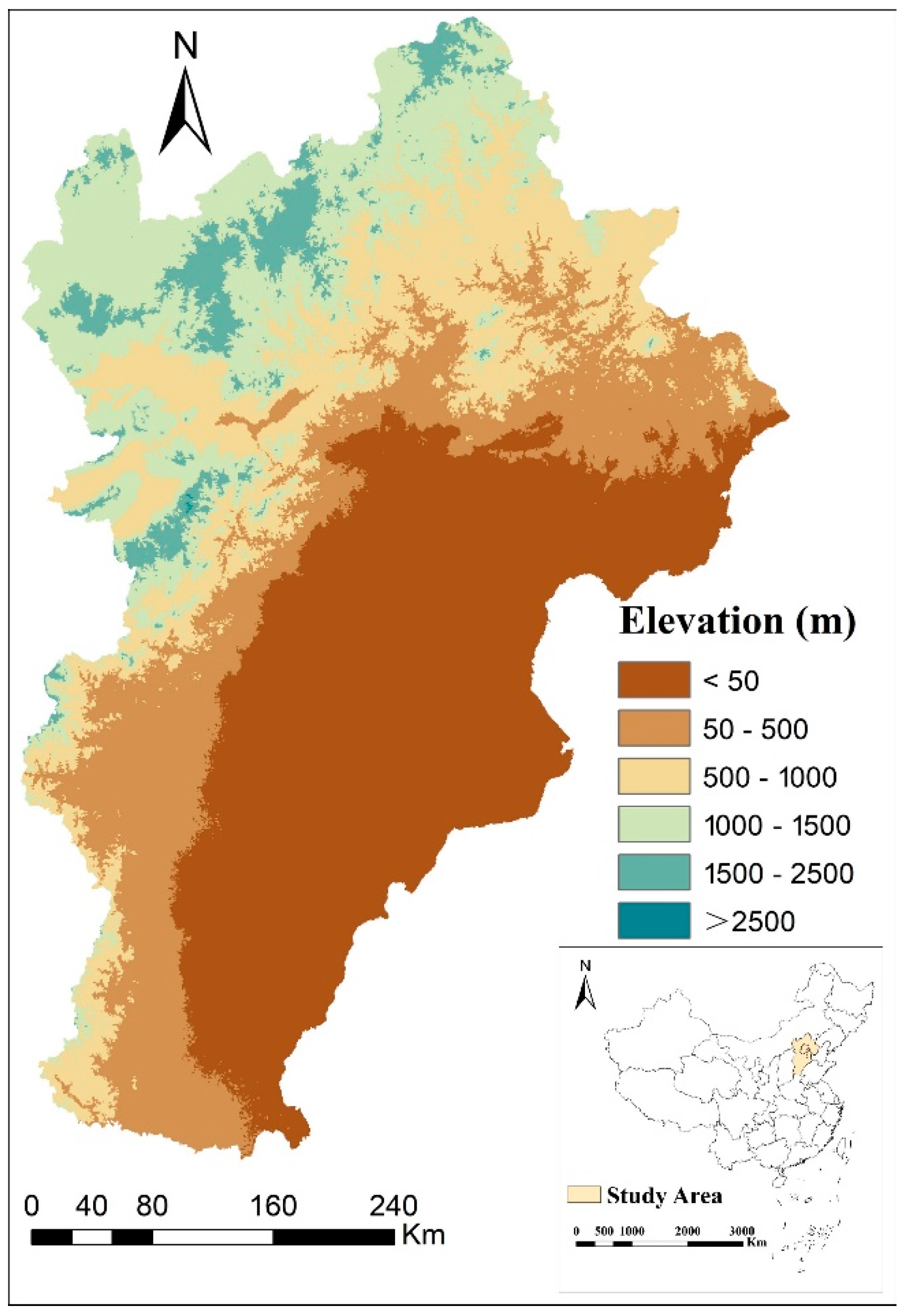
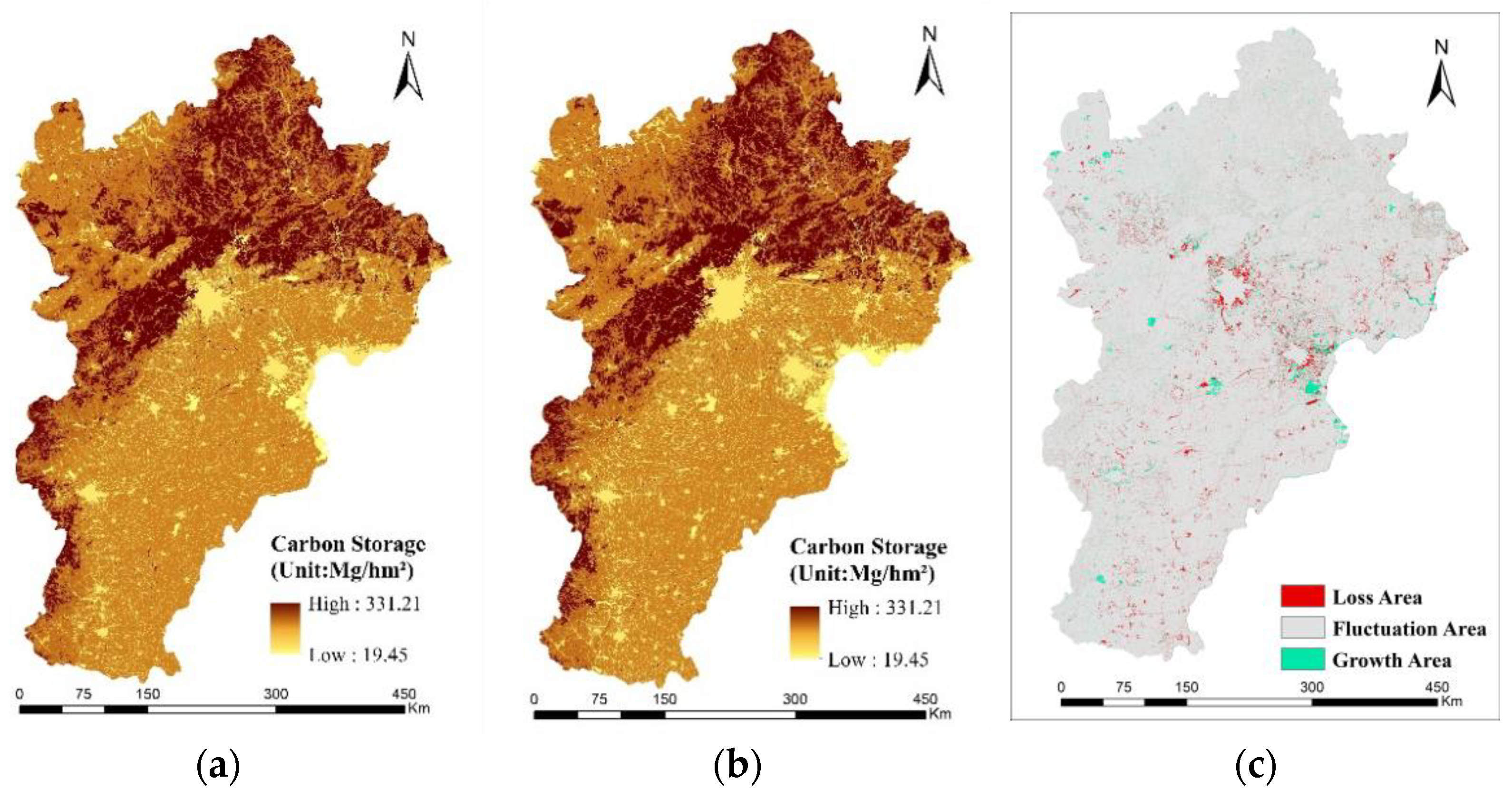
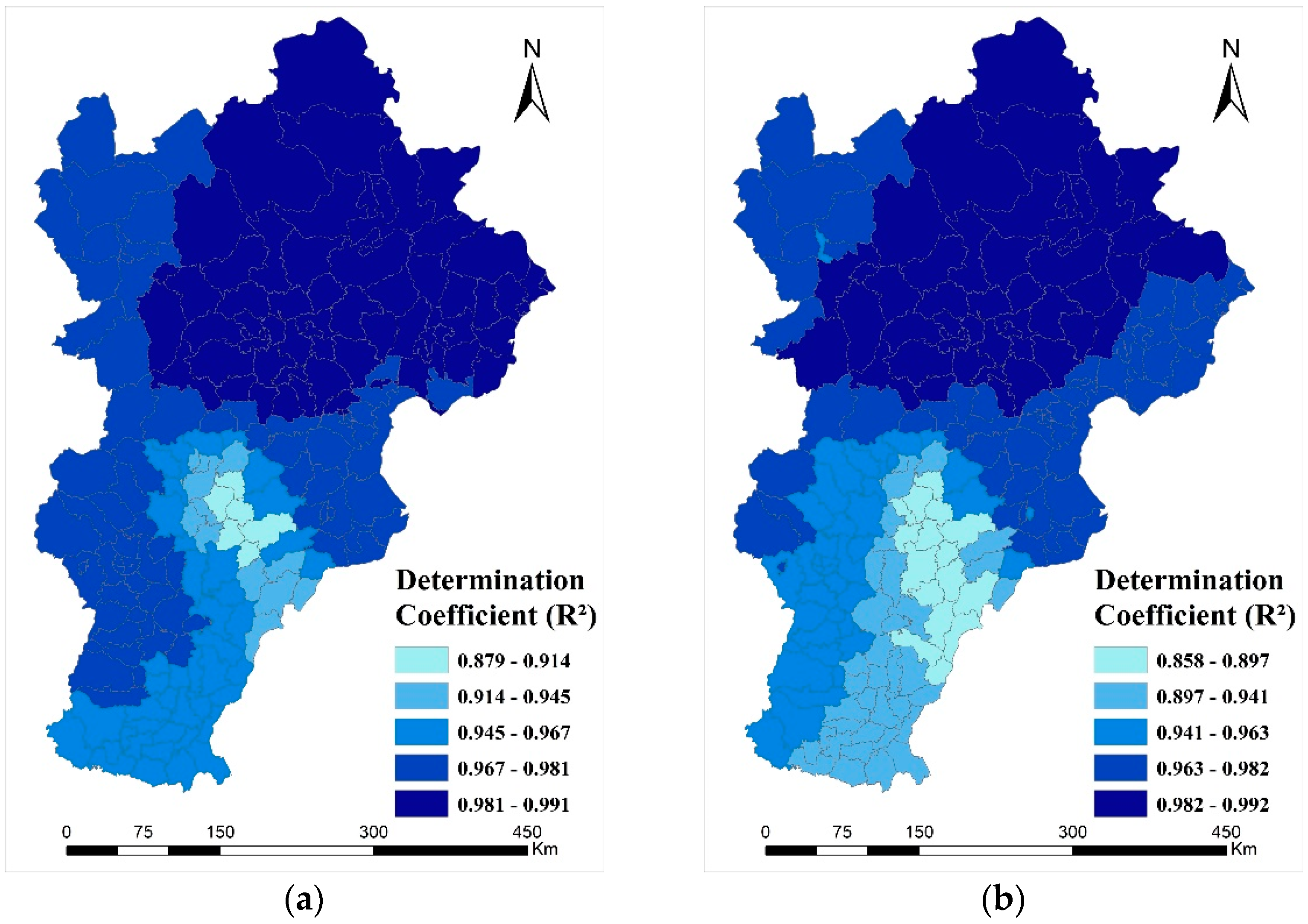
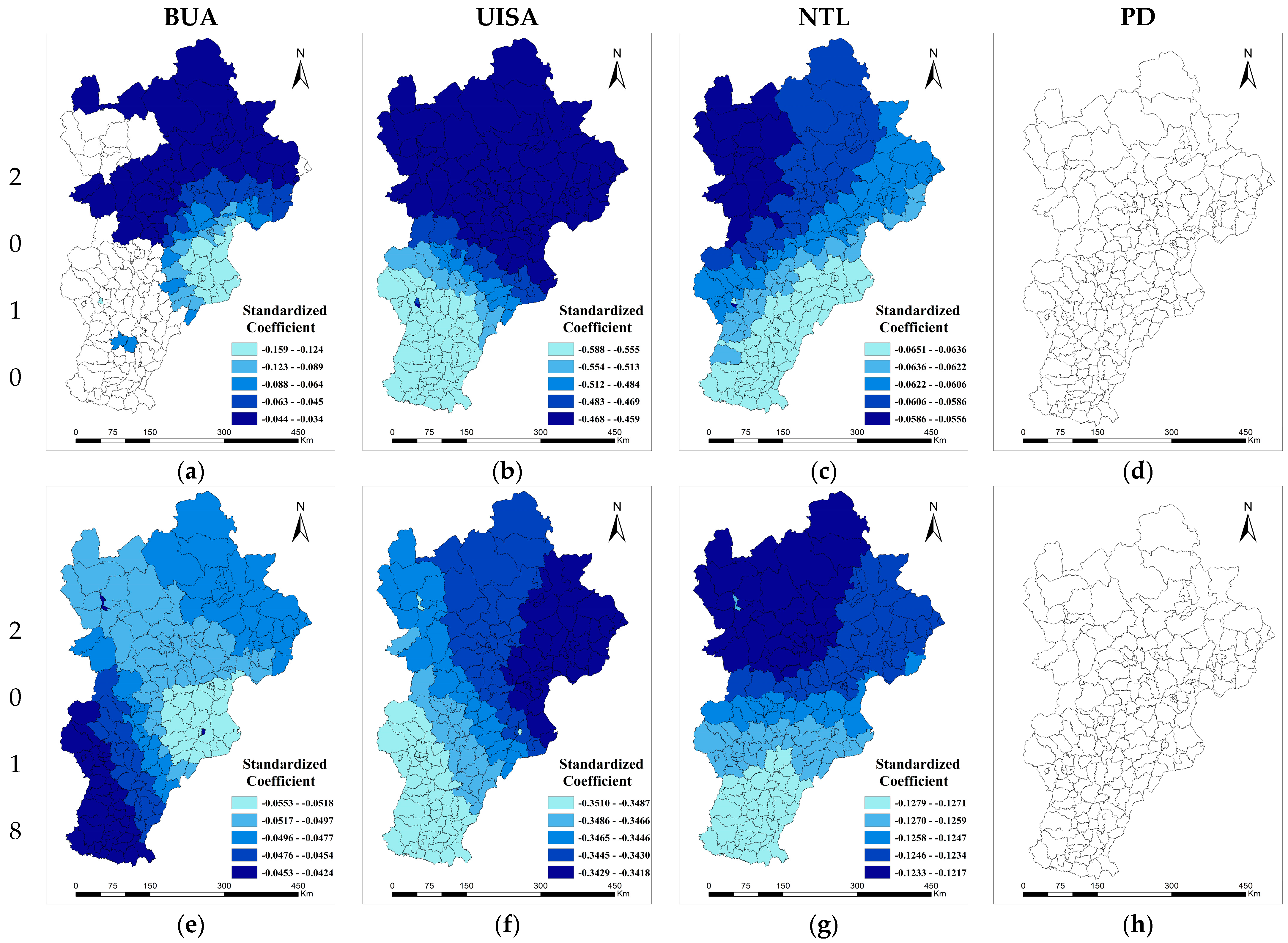
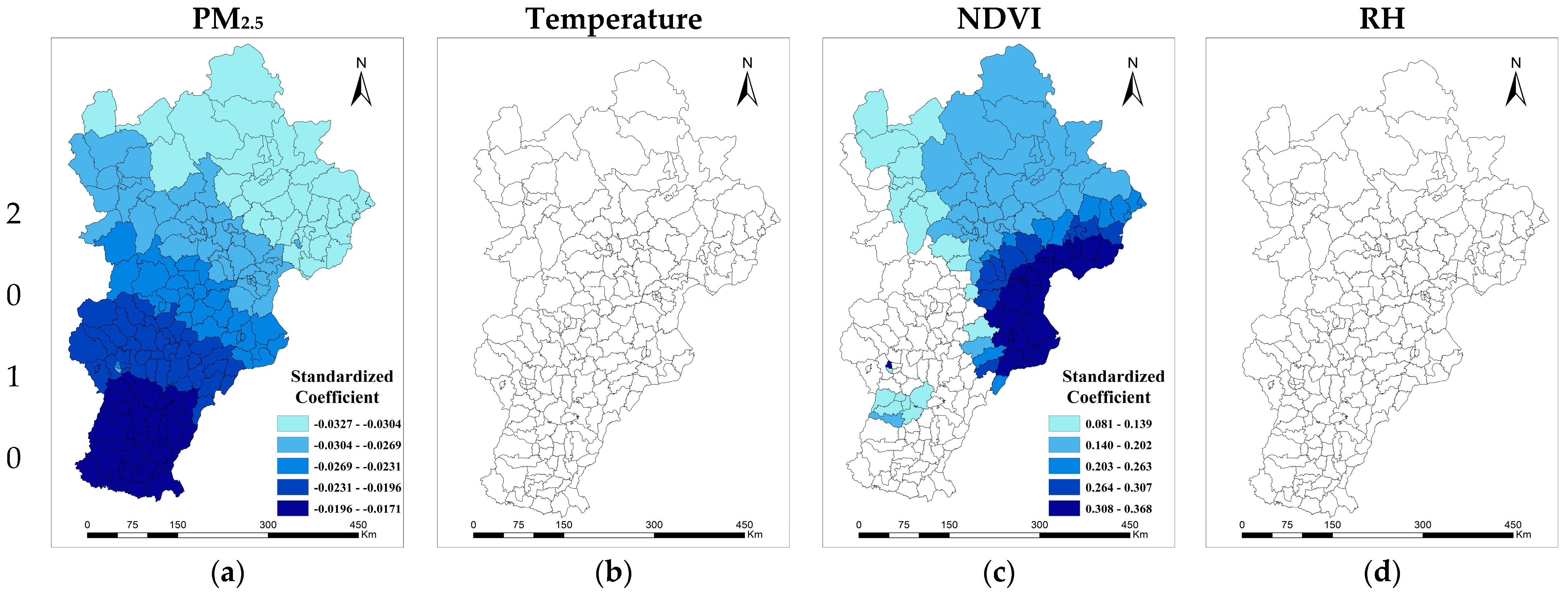
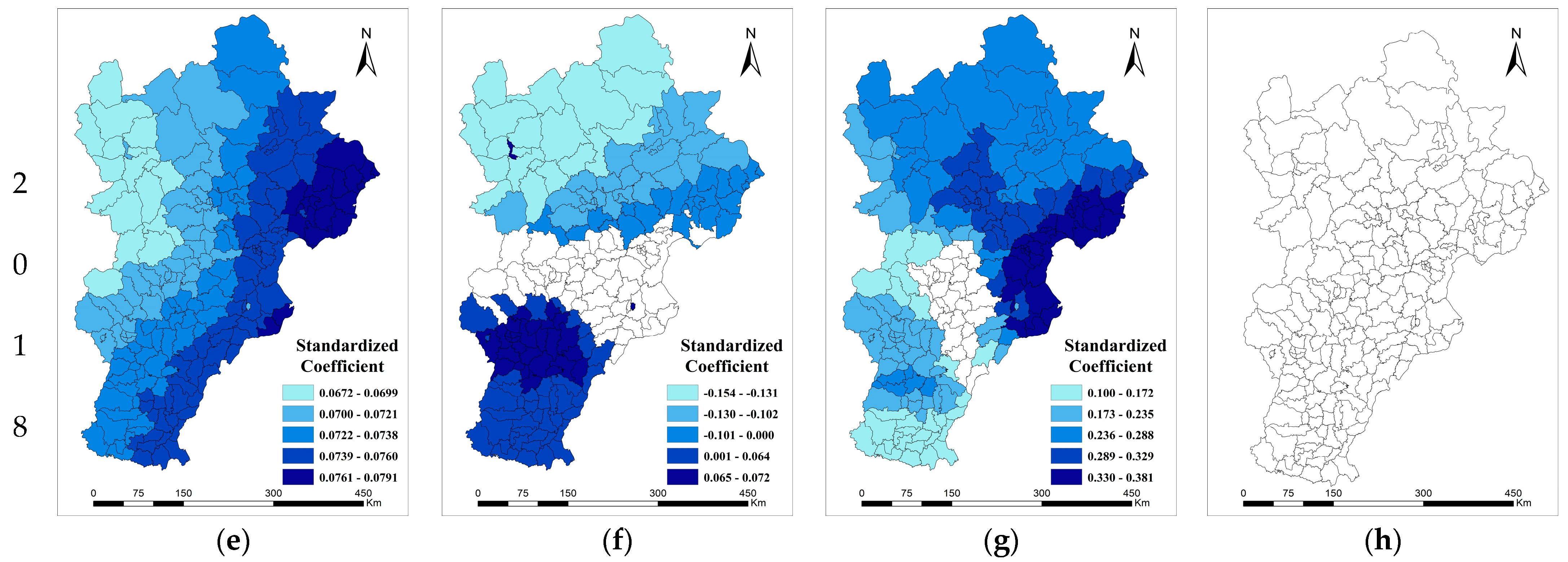
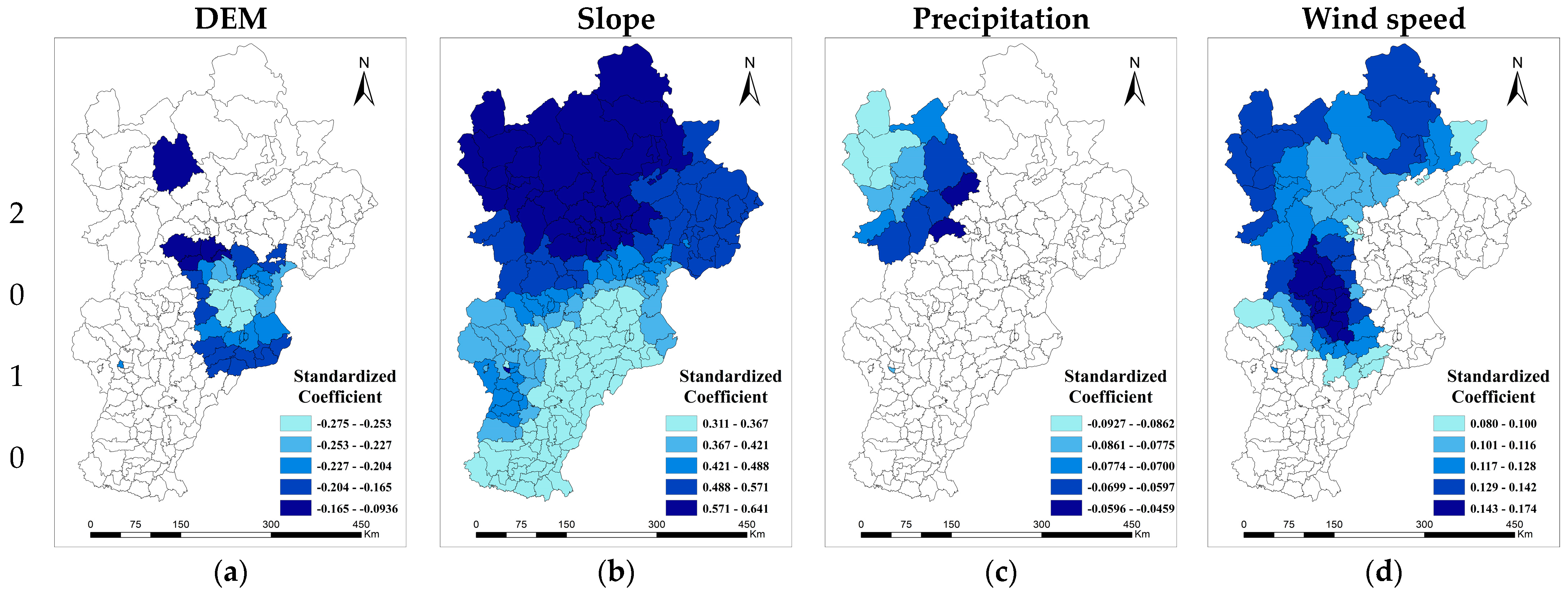
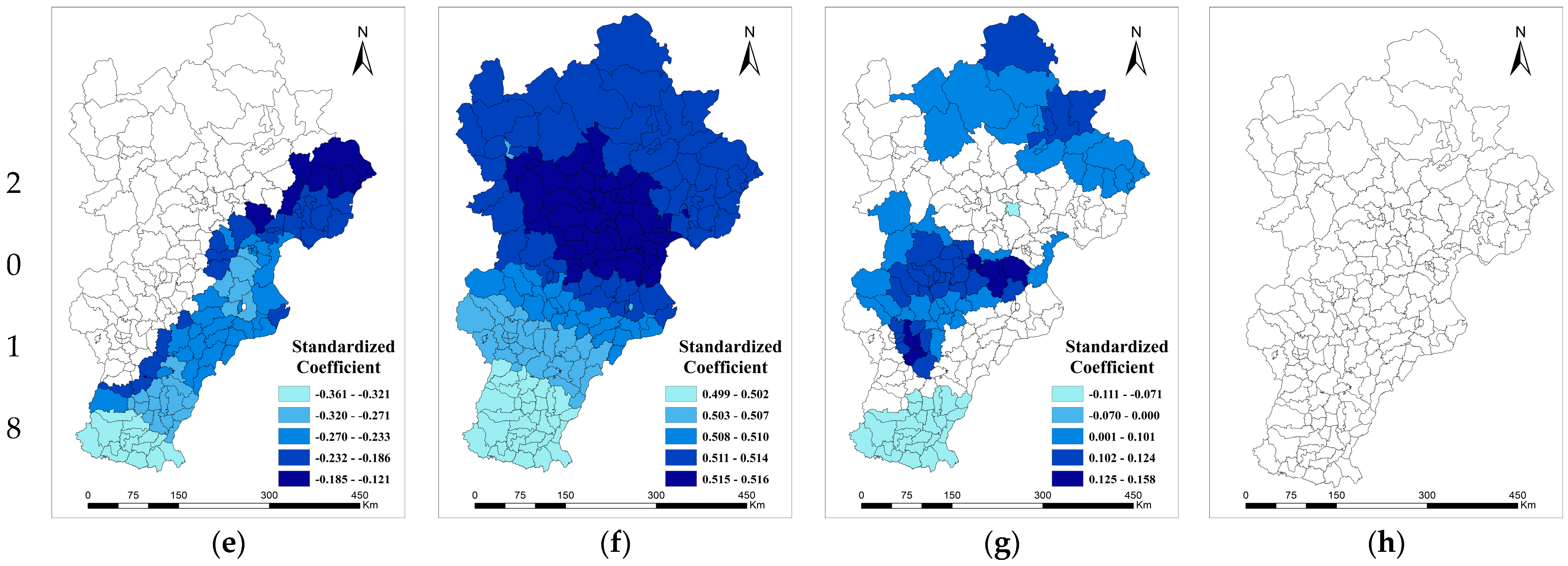
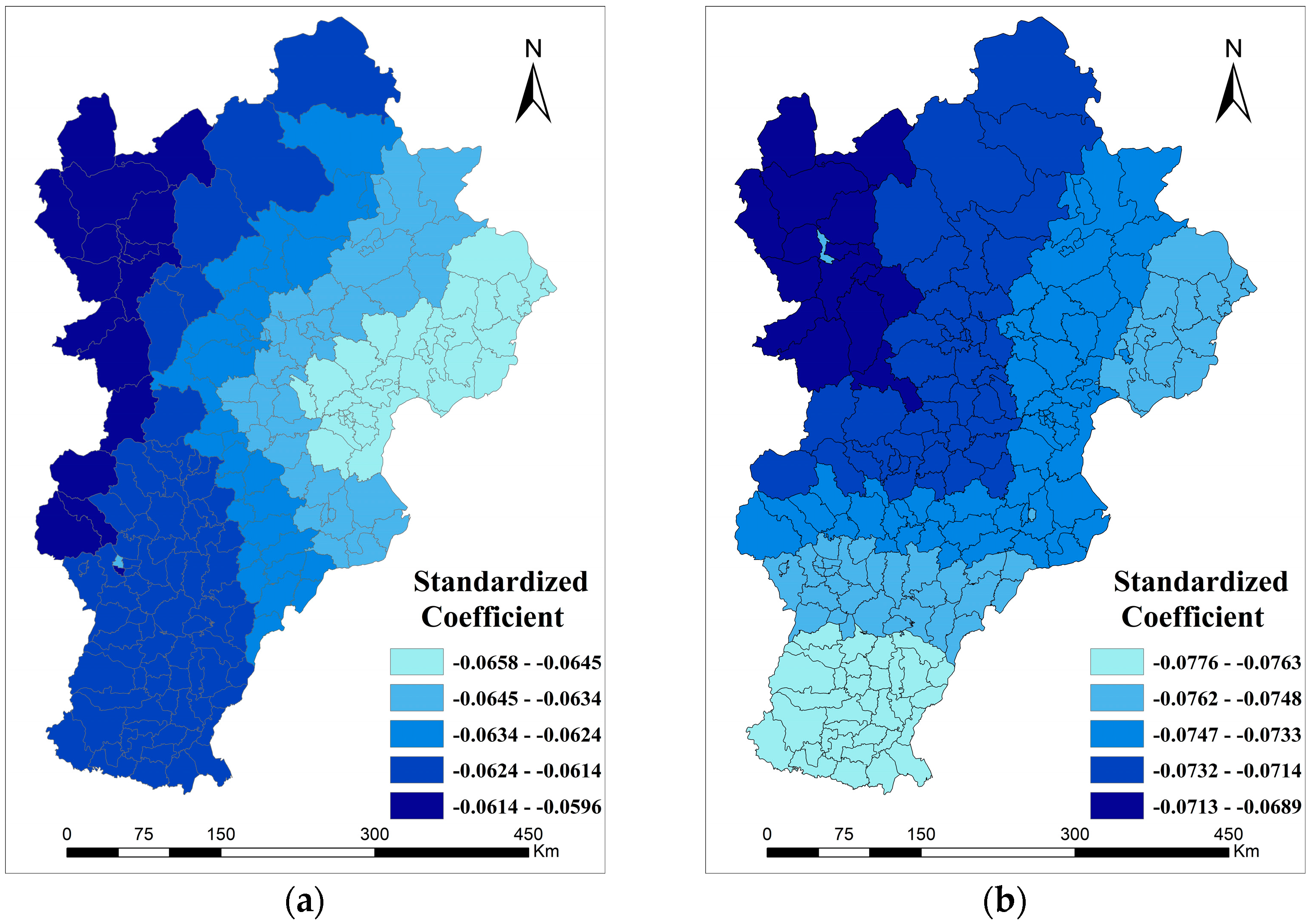
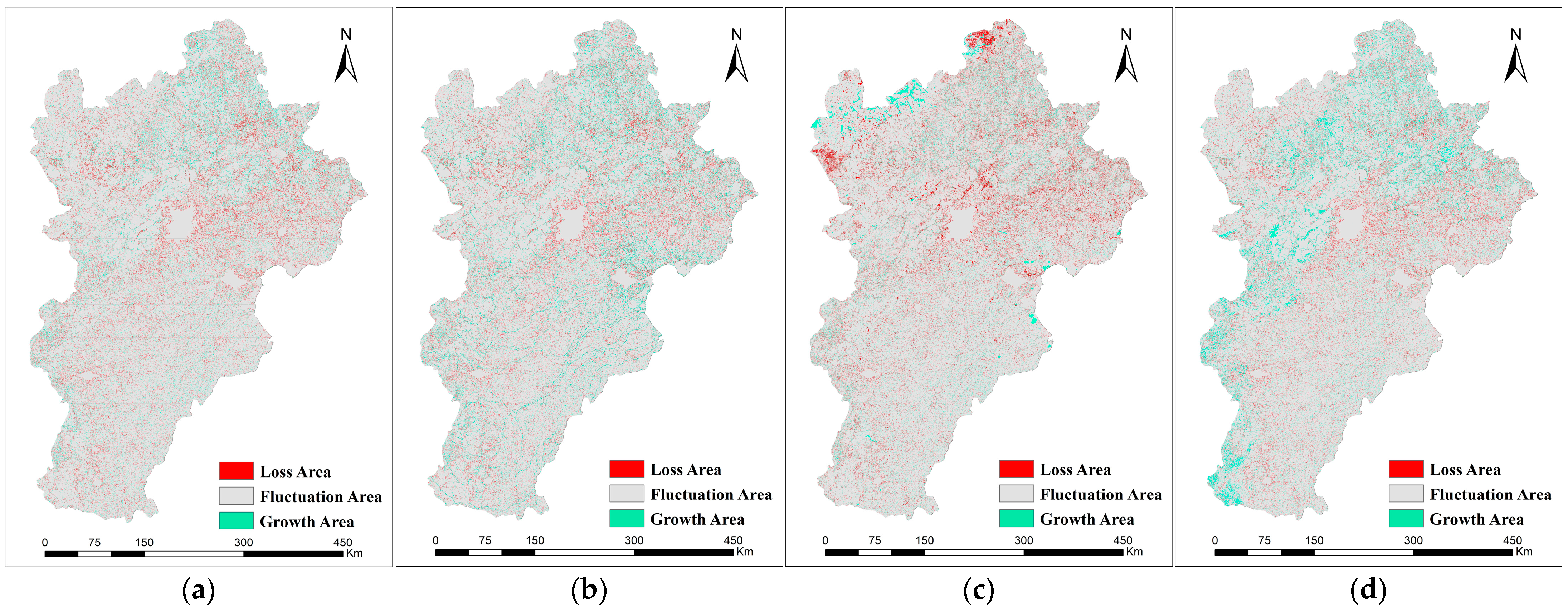
| Variable | Year | N | Std. Dev. | Mean | Max | Min | Median | Data Source |
|---|---|---|---|---|---|---|---|---|
| C (Mg/hm2) | 2010 | 199 | 47.95 | 182.57 | 303.85 | 54.27 | 182.94 | / |
| 2018 | 199 | 49.19 | 178.50 | 302.17 | 54.29 | 179.47 | ||
| BUA (km2) | 2010 | 199 | 67.10 | 73.55 | 414.36 | 3.06 | 54.54 | China Land Cover Dataset [45] |
| 2018 | 199 | 77.911 | 96.02 | 477.63 | 5.22 | 78.75 | ||
| NTL (DN value) | 2010 | 199 | 15.27 | 12.99 | 63 | 0.15 | 7.52 | available literature [48] |
| 2018 | 199 | 15.67 | 15.99 | 60.51 | 0.44 | 9.44 | ||
| UISA | 2010 | 199 | 0.19 | 0.092 | 0.88 | 0 | 0.02 | available literature [49] |
| 2018 | 199 | 0.19 | 0.100 | 0.88 | 0 | 0.02 | ||
| PD (Person/km2) | 2010 | 199 | 4837 | 1996 | 31176 | 41 | 630 | China City Statistical Yearbook |
| 2018 | 199 | 5979 | 2335 | 38029 | 42 | 668 | ||
| NDVI (1/103) | 2010 | 199 | 77.93 | 283.53 | 492.12 | 79.21 | 287.92 | MOD13A2 |
| 2018 | 199 | 86.57 | 307.27 | 508.98 | 97.81 | 308.08 | ||
| PM2.5 (μg/m3) | 2010 | 199 | 21.08 | 75.11 | 113.01 | 24.27 | 78.42 | CHAP [46] |
| 2018 | 199 | 13.80 | 54.19 | 81.97 | 20.13 | 57.01 | ||
| Temp (°C) | 2010 | 199 | 2.01 | 11.60 | 14.30 | 4.73 | 12.27 | Resource and Environment Science and Data Center (www.resdc.cn (accessed on 12 August 2022)) |
| 2018 | 199 | 1.971 | 12.29 | 14.99 | 5.57 | 12.82 | ||
| RH (%) | 2010 | 199 | 3.02 | 57.91 | 70.17 | 50.11 | 57.80 | |
| 2018 | 199 | 3.50 | 56.99 | 67.43 | 46.63 | 57.46 | ||
| WS (m/s) | 2010 | 199 | 0.34 | 2.22 | 3.25 | 1.54 | 2.17 | |
| 2018 | 199 | 0.304 | 2.28 | 3.16 | 1.62 | 2.25 | ||
| Pre (mm) | 2010 | 199 | 69.53 | 607.60 | 797.48 | 418.89 | 600.90 | |
| 2018 | 199 | 56.18 | 596.90 | 703.19 | 420.42 | 613.24 | ||
| DEM (m) | / | 199 | 362.17 | 227.63 | 1487.01 | 2.07 | 43.88 | SRTM |
| Slope (°) | / | 199 | 4.64 | 3.618 | 18.76 | 0.349 | 0.69 |
| Types | AGC | BGC | SOC | DOC |
|---|---|---|---|---|
| Cultivated land | 17 | 87.7 | 92.9 | 9.82 |
| Woodland | 42.4 | 115.9 | 158.8 | 14.11 |
| Grassland | 35.3 | 86.5 | 99.9 | 7.28 |
| Water | 2.29 | 0 | 17.16 | 0 |
| Urban | 7.61 | 4.51 | 42.17 | 0 |
| Bare land | 9.1 | 14.2 | 22.63 | 0 |
| 2010 | 2018 | |
|---|---|---|
| Moran’s Index | 0.563 | 0.561 |
| Z-score | 19.51 | 19.47 |
| p-value | <0.001 | <0.001 |
| Int. | BUA | NTL | UISA | PD | NDVI | PM2.5 | Temp | RH | Ws | Pre | DEM | Slope | |
|---|---|---|---|---|---|---|---|---|---|---|---|---|---|
| Mean | −0.063 | −0.055 | −0.062 | −0.505 | 0.044 | 0.143 | −0.025 | −0.012 | −0.002 | 0.062 | −0.019 | −0.063 | 0.453 |
| STD | 0.001 | 0.031 | 0.002 | 0.052 | 0.001 | 0.115 | 0.005 | 0.009 | 0.001 | 0.056 | 0.019 | 0.001 | 0.106 |
| Min | −0.066 | −0.159 | −0.065 | −0.588 | 0.043 | −0.013 | −0.033 | −0.027 | −0.005 | −0.044 | −0.093 | −0.066 | 0.31 |
| Median | −0.062 | −0.045 | −0.062 | −0.468 | 0.043 | 0.112 | −0.025 | −0.009 | −0.002 | 0.052 | −0.015 | −0.062 | 0.424 |
| Max | −0.06 | −0.02 | −0.056 | −0.459 | 0.045 | 0.368 | −0.017 | 0 | 0 | 0.174 | −0.001 | −0.06 | 0.642 |
| Bandwidth | 196 | 73 | 195 | 129 | 196 | 44 | 176 | 153 | 196 | 63 | 131 | 43 | 43 |
| Diagnostics Info: | |||||||||||||
| R2 | 0.983 | ||||||||||||
| Adj. R2 | 0.978 | ||||||||||||
| AICC | −128.138 | ||||||||||||
| Residual Sum of Squares | 3.379 | ||||||||||||
| Int. | BUA | NTL | UISA | PD | NDVI | PM2.5 | Temp. | RH | Ws | Pre. | DEM | Slope | |
|---|---|---|---|---|---|---|---|---|---|---|---|---|---|
| Mean | −0.074 | −0.049 | −0.125 | −0.346 | 0.012 | 0.223 | 0.073 | −0.019 | 0.024 | −0.002 | 0.034 | −0.124 | 0.51 |
| STD | 0.002 | 0.003 | 0.002 | 0.003 | 0.017 | 0.105 | 0.002 | 0.079 | 0.002 | 0.012 | 0.074 | 0.138 | 0.005 |
| Min | −0.078 | −0.055 | −0.128 | −0.351 | −0.004 | −0.077 | 0.067 | −0.154 | 0.019 | −0.019 | −0.111 | −0.361 | 0.499 |
| Median | −0.074 | −0.049 | −0.125 | −0.345 | 0.001 | 0.238 | 0.073 | −0.001 | 0.025 | −0.001 | 0.065 | −0.132 | 0.513 |
| Max | −0.069 | −0.042 | −0.122 | −0.342 | 0.063 | 0.381 | 0.079 | 0.072 | 0.026 | 0.016 | 0.158 | 0.094 | 0.516 |
| Bandwidth | 196 | 186 | 196 | 192 | 143 | 45 | 179 | 119 | 196 | 192 | 43 | 43 | 196 |
| Diagnostics Info: | |||||||||||||
| R2 | 0.980 | ||||||||||||
| Adj. R2 | 0.975 | ||||||||||||
| AICC | −107.198 | ||||||||||||
| RSS | 3.983 | ||||||||||||
| 2010 | 2018 | |
|---|---|---|
| Bandwidth | 81 | 88 |
| R2 | 0.986 | 0.985 |
| Adj. R2 | 0.981 | 0.978 |
| AICC | −129.664 | −109.886 |
| RSS | 3.739 | 4.025 |
| Scenario | Settings | Carbon Storage Loss (Tg C) |
|---|---|---|
| Natural Development | Projections based on changes from 2010–2018 | 112.5 |
| Woodland buffer zone | Convert 100 m of the area near the water to woodland | 8.5 |
| Agricultural expansion | Conversion of woodland, grassland, and unused land with slopes below 6° into cultivated land | 62.2 |
| Forest rehabilitation from slope agriculture | Convert cultivated land and unused land with slopes of 15–25° to forest land, and convert grassland with slopes >25° to forest land | 2.3 |
Publisher’s Note: MDPI stays neutral with regard to jurisdictional claims in published maps and institutional affiliations. |
© 2022 by the authors. Licensee MDPI, Basel, Switzerland. This article is an open access article distributed under the terms and conditions of the Creative Commons Attribution (CC BY) license (https://creativecommons.org/licenses/by/4.0/).
Share and Cite
Niu, L.; Zhang, Z.; Liang, Y.; Huang, Y. Assessing the Impact of Urbanization and Eco-Environmental Quality on Regional Carbon Storage: A Multiscale Spatio-Temporal Analysis Framework. Remote Sens. 2022, 14, 4007. https://doi.org/10.3390/rs14164007
Niu L, Zhang Z, Liang Y, Huang Y. Assessing the Impact of Urbanization and Eco-Environmental Quality on Regional Carbon Storage: A Multiscale Spatio-Temporal Analysis Framework. Remote Sensing. 2022; 14(16):4007. https://doi.org/10.3390/rs14164007
Chicago/Turabian StyleNiu, Lu, Zhengfeng Zhang, Yingzi Liang, and Yanfen Huang. 2022. "Assessing the Impact of Urbanization and Eco-Environmental Quality on Regional Carbon Storage: A Multiscale Spatio-Temporal Analysis Framework" Remote Sensing 14, no. 16: 4007. https://doi.org/10.3390/rs14164007
APA StyleNiu, L., Zhang, Z., Liang, Y., & Huang, Y. (2022). Assessing the Impact of Urbanization and Eco-Environmental Quality on Regional Carbon Storage: A Multiscale Spatio-Temporal Analysis Framework. Remote Sensing, 14(16), 4007. https://doi.org/10.3390/rs14164007







